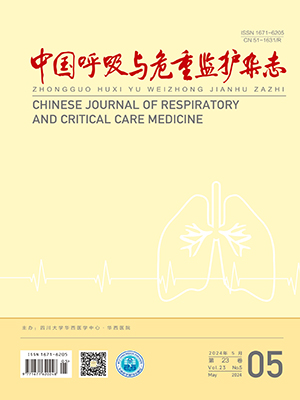| 1. |
Galiè N, Humbert M, Vachiery JL, et al. 2015 ESC/ERS Guidelines for the diagnosis and treatment of pulmonary hypertension: The Joint Task Force for the Diagnosis and Treatment of Pulmonary Hypertension of the European Society of Cardiology (ESC) and the European Respiratory Society (ERS): Endorsed by: Association for European Paediatric and Congenital Cardiology (AEPC), International Society for Heart and Lung Transplantation (ISHLT). Eur Respir J, 2015, 46(4): 903-975.
|
| 2. |
Cook DP, Xu M, Martucci VL, et al. Clinical insights into pulmonary hypertension in chronic obstructive pulmonary disease. Pulm Circ, 2022, 12(1): e12006.
|
| 3. |
魏慧, 罗增, 次旦央宗, 等. 高原地区不同海拔高度腹型过敏性紫癜患者临床特征分析. 北京大学学报(医学版), 2021, 53(6): 1072-1077.
|
| 4. |
Aguirre-Franco C, Torres-Duque CA, Salazar G, et al. Prevalence of pulmonary hypertension in COPD patients living at high altitude. Pulmonology, 2022.
|
| 5. |
Mørland JG, Magnus P, Vollset SE, et al. Associations between serum high-density lipoprotein cholesterol levels and cause-specific mortality in a general population of 345 000 men and women aged 20-79 years. Int J Epidemiol, 2023, 52(4): 1257-1267.
|
| 6. |
Umar S, Ruffenach G, Moazeni S, et al. Involvement of Low-Density Lipoprotein Receptor in the Pathogenesis of Pulmonary Hypertension. J Am Heart Assoc, 2020, 9(2): e012063.
|
| 7. |
周敏. 2020版慢性阻塞性肺疾病全球倡议解读. 中华结核和呼吸杂志, 2020(03): 268-271.
|
| 8. |
中华医学会呼吸病学分会肺栓塞与肺血管病学组, 中国医师协会呼吸医师分会肺栓塞与肺血管病工作委员会, 全国肺栓塞与肺血管病防治协作组, 等. 中国肺动脉高压诊断与治疗指南(2021版). 中华医学杂志, 2021, 101(1): 11-51.
|
| 9. |
Wang C, Xu J, Yang L, et al. Prevalence and risk factors of chronic obstructive pulmonary disease in China (the China Pulmonary Health [CPH] study): a national cross-sectional study. Lancet, 2018, 391(10131): 1706-1717.
|
| 10. |
Wood A M, Kaptoge S, Butterworth AS, et al. Risk thresholds for alcohol consumption: combined analysis of individual-participant data for 599 912 current drinkers in 83 prospective studies. Lancet, 2018, 391(10129): 1513-1523.
|
| 11. |
The Lancet Respiratory M. COPD: a complex, multifactorial, but preventable disease? Lancet Respir Med, 2022, 10(5): 421.
|
| 12. |
Dobric A, De Luca SN, Spencer SJ, et al. Novel pharmacological strategies to treat cognitive dysfunction in chronic obstructive pulmonary disease. Pharmacol Ther, 2022, 233: 108017.
|
| 13. |
Awerbach JD, Stackhouse KA, Lee J, et al. Outcomes of lung disease-associated pulmonary hypertension and impact of elevated pulmonary vascular resistance. Respir Med, 2019, 150: 126-130.
|
| 14. |
Hurdman J, Condliffe R, Elliot CA, et al. Pulmonary hypertension in COPD: results from the ASPIRE registry. Eur Respir J, 2013, 41(6): 1292-301.
|
| 15. |
Torres-Castro R, Gimeno-Santos E, Vilaró J, et al. Effect of pulmonary hypertension on exercise tolerance in patients with COPD: a prognostic systematic review and meta-analysis. Eur Respir Rev, 2021, 30(160).
|
| 16. |
Wang GF, Guan LH, Zhou DX, et al. Serum High-Density Lipoprotein Cholesterol is Significantly Associated with the Presence and Severity of Pulmonary Arterial Hypertension: A Retrospective Cross-Sectional Study. Adv Ther, 2020, 37(5): 2199-2209.
|
| 17. |
Pooja, Sharma V, Meena RN, et al. TMT-Based Plasma Proteomics Reveals Dyslipidemia Among Lowlanders During Prolonged Stay at High Altitudes. Front Physiol, 2021, 12: 730601.
|
| 18. |
Siques P, Brito J, Naveas N, et al. Plasma and liver lipid profiles in rats exposed to chronic hypobaric hypoxia: changes in metabolic pathways. High Alt Med Biol, 2014, 15(3): 388-95.
|
| 19. |
Ortiz-Prado E, Portilla D, Mosquera-Moscoso J, et al. Hematological Parameters, Lipid Profile, and Cardiovascular Risk Analysis Among Genotype-Controlled Indigenous Kiwcha Men and Women Living at Low and High Altitudes. Front Physiol, 2021, 12: 749006.
|
| 20. |
尼玛玉珍, 德央, 史建玲, 等. 西藏不同海拔地区藏族人群高原性心脏病的超声心动图指标分析. 中华医学超声杂志(电子版), 2019, 16(4): 306-310.
|
| 21. |
Wang L, Wang F, Tuo Y, et al. Clinical characteristics and predictors of pulmonary hypertension in chronic obstructive pulmonary disease at different altitudes. BMC Pulm Med, 2023, 23(1): 127.
|
| 22. |
Morris H, Denver N, Gaw R, et al. Sex Differences in Pulmonary Hypertension. Clin Chest Med, 2021, 42(1): 217-228.
|
| 23. |
Singh N, Dorfmüller P, Shlobin OA, et al. Group 3 Pulmonary Hypertension: From Bench to Bedside. Circ Res, 2022, 130(9): 1404-1422.
|
| 24. |
Dunham-Snary KJ, Wu D, Sykes EA, et al. Hypoxic Pulmonary Vasoconstriction: From Molecular Mechanisms to Medicine. Chest, 2017, 151(1): 181-192.
|
| 25. |
Calvier L, Herz J, Hansmann G. Interplay of Low-Density Lipoprotein Receptors, LRPs, and Lipoproteins in Pulmonary Hypertension. JACC Basic Transl Sci, 2022, 7(2): 164-180.
|
| 26. |
Rosenson RS, Brewer HB, Ansell BJ, et al. Dysfunctional HDL and atherosclerotic cardiovascular disease. Nat Rev Cardiol, 2016, 13(1): 48-60.
|
| 27. |
Ertek S. High-density Lipoprotein (HDL) Dysfunction and the Future of HDL. Curr Vasc Pharmacol, 2018, 16(5): 490-498.
|
| 28. |
Chiesa ST, Charakida M. High-Density Lipoprotein Function and Dysfunction in Health and Disease. Cardiovasc Drugs Ther, 2019, 33(2): 207-219.
|
| 29. |
Bains Y, Caccavello R, Kotani K, et al. Paraoxonase 1, HDL Subclasses and Post Surgery Acute Inflammation: A Pilot Study. Antioxidants (Basel), 2019, 8(6).
|
| 30. |
Samareh Fekri M, Torabi M, Azizi Shoul S, et al. Prevalence and predictors associated with severe pulmonary hypertension in COPD. Am J Emerg Med, 2018, 36(2): 277-280.
|
| 31. |
Donini LM, Pinto A, Giusti AM, et al. Obesity or BMI Paradox? Beneath the Tip of the Iceberg. Front Nutr, 2020, 7: 53.
|




